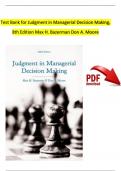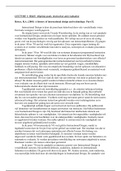Test Bank for Judgment in Managerial Decision Making,
8th Edition Max H. Bazerman Don A. Moore
, Chapter 1 Introduction to Managerial Decision Making
Multiple choice
1) An optimal search for alternatives should last:
a. As long as needed to find the best solution.
b. As long as needed to find the first good enough solution.
c. As long as the cost of the search does not outweigh the value of the added information.
d. As long as the cost of the search is within the appropriate limits set by the decision maker.
Ans: c
Response: p. 2-3
2) Rating alternatives on each of the decision criteria is considered the most difficult stage of the
decision-making process, because:
a. It assumes we have precisely defined our priorities.
b. It requires us to forecast how each alternative solution will achieve each of our decision
criteria.
c. It requires us to compare all of the alternatives simultaneously.
d. It is likely to fail if our problem is not defined correctly, and this failure will not be detected.
Ans: b
Response: p. 3
3) In the interplay between system 1 and system 2 thinking, the key goal for managers is:
a. To improve their use of system 1 thinking.
b. To attempt to use system 2 thinking as much as possible.
c. To apply both systems in making decisions in order to perform a more thorough and
complex search for alternatives.
d. To identify when they should move from system 1 to system 2 thinking. Ans: d
Response: p. 4
, 4) Which of the following is a typical characteristic of heuristics?
a. They provide us with a simple way of dealing with complex problems.
b. They have the best likelihood of reaching an optimal solution to a problem.
c. They are time and resource consuming.
d. They are used mainly by irrational decision makers.
Ans: a
Response: p. 6
Questions 5-8 describe examples of heuristics outlined in the chapter. For each question, indicate which
heuristic it describes:
a. The representativeness heuristic.
b. The availability heuristic.
c. The confirmation heuristic.
d. The affect heuristic.
5) Inner city crime in the U.S. gets considerable media coverage, such that every homicide is
reported in the news. In contrast, a story of a person who died from a heart attack rarely makes
the news. This leads people to overestimate the frequency of deaths due to homicides relative
to those due to heart failure.
Ans: b
Response: p. 7-8
6) John is over seven feet tall. When asked whether John is a professional basketball player or a
software programmer, many people predict the former, even though there are many more
software programmers, even very tall ones, than professional basketball players. Ans: a
Response: p. 8-9
, 7) After reading about the positive effect chocolate has on student performance, a teacher gives
each student in a class a chocolate bar before taking an exam. 15 out of 22 students in that class
get an A on the exam. The teacher therefore concludes that chocolate enhances performance.
Ans: c
Response: p. 9-10
8) A common wisdom in politics is that the more an argument is repeated, the more it will be
considered by the public as reliable and true.
Ans: b
Response: p. 7-8
9) The affect heuristic can explain why
a. People who live in California are assumed to be happier than people who live in the
Midwest.
b. Students predict they will be sadder after getting a bad grade on a test than they
actually are in these situations.
c. People do not remember sad events from their early childhood.
d. Stock prices go up on sunny days.
Ans: d
Response: p. 10
True/False
10) Succumbing to heuristics is inevitable, and there is no way to make judgment less prone them.
Rather, one can only be aware of the biasing effect heuristics have on one’s judgment.
Ans: False
Response: p. 11
, 11) A search for alternatives may be too short to find the best possible alternative, but still be
considered rational and optimal.
Ans: True
Response: p. 2-3
12) The main disadvantage of system 2 thinking is its high resource consumption.
Ans: true
Response: p. 3
13) This book takes a descriptive, rather than a prescriptive approach, to studying decision making,
meaning that it provides ways to understand actual human decision making, but does not
provide tools for improving one’s decision processes.
Ans: false
Response: p. 5
Short answer
14) Which of the two cognitive systems (System 1 and System 2) is most often used, and in what
kinds of decision is it typically used?
Ans: System 1 thinking is used more often. It is used typically in routine, everyday choices.
Response: p. 3-4
13-15. Identify three constraints on rational thought that may lead to suboptimal outcomes:
15) Time and cost constraints that limit information search.
16) Memory constraints on the amount of information stored.
17) Intelligence limitations and perceptual errors that constrain the ability to choose the optimal
alternative.
Response: p. 5-6
, 18) Describe the term “to satisfice”
Ans: to satisfice is to end the search for alternatives when we find a satisfactory solution that
achieves a satisfactory level of performance, rather than examine all possible alternatives or
look for the best solution.
Response: p. 5-6
Essay
19) In what ways is our rationality bounded? Discuss the aspects that are bounded in our judgment
and how they are bounded.
Our willpower is bounded, such that we tend to give greater weight to present concerns than to
future concerns. Our self-interest is bounded, such that we care not only about our own
outcomes, but also about the outcomes of others. Our awareness is bounded in a way that
makes us overlook obvious, important, and readily available information that lies beyond our
immediate attention. Our ethicality is also bounded, or is limited in ways of which we are
unaware.
Response: p. 6
20) What affects whether system 1 thinking or system 2 thinking will occur? What are the
conditions which make the use of one system more likely than the use of the other?
Ans: the chosen system depends in part on the level of constraint on people’s resources –
mainly cognitive load, time, and money. When these resources are not limited, i.e. when people
have enough time, money and peace of mind to conduct a thorough decision-making process,
they will use system 2 thinking. In contrast, the busier and more rushed people are, the more
they have on their minds, therefore they are more likely to rely on system 1 thinking. System 2
is also more likely to take over when people realize that system 1 is failing to produce
satisfactory results.
Response: p. 3-4
, Chapter 2 Overconfidence
Multiple choice
1) What is the name given to the tendency to be too sure that our judgments and decisions are
accurate?
a. Overprecision
b. Overestimation
c. Overplacement
d. Overjustification
Ans: a
Response: p. 15
2) What is the name given to the tendency to think we are better than we actually are?
a. Overprecision
b. Overestimation
c. Overplacement
d. Overjustification
Ans: b
Response: p. 15
3) What is the name given to the tendency to falsely think we rank higher than others on certain
dimensions?
a. Overprecision
b. Overestimation
c. Overplacement
d. Overjustification
Ans: c
Response: p. 15
4) In what ways is it beneficial to outwardly express confidence?
a. People feel better about themselves.
b. People perform better because they face a lot of pressure to justify their confident
predictions.
c. People are more persuasive and capable of attaining status when they portray
confidence.
d. The outward expression of confidence is not beneficial.
, Ans: c
Response: p. 19-20
5) Which of the following is a common mistake made by investors?
a. They don’t invest enough money.
b. They trade too often.
c. They take on too much risk in their portfolios.
d. They don’t correctly time the market.
Ans: c
Response: p. 21-22
6) When are we the most likely to overplace our performance relative to others?
a. When we are in a good mood.
b. When we are trying to impress others.
c. When we are working on an easy task.
d. None of the above.
Ans: c
Response: p. 26-27
True / False
7) Overconfidence is so robust that research has failed to identify situations in which we are likely
to be underconfident.
Ans: False
Response: p. 26
8) People tend to overestimate their control in situations where they have objectively little
control.
Ans: True
Response: p. 23
9) There are advantages to having positive illusions.
Ans: True
Response: p. 28
,Short answer
10) Why do we tend to overplace our ability relative to others on easy tasks?
Ans: While we tend to underestimate our performance, we tend to underestimate the
performance of others to an even larger extent because we fail to adequately consider the skill
of the competition.
Response: p. 27
11) What is the potential downside to portraying confidence to others?
Ans: If you are exposed as wrong despite being confident, you lose credibility and your
reputation suffers.
Response: p. 20
12) What is the planning fallacy and when is it the most likely to occur?
Ans: The tendency to overestimate the speed at which we will complete projects and tasks. It is
particularly likely to occur in the context of large, complex projects that are prone to
complications.
Response: p. 23-24
13) Why do many argue that overplacement is more problematic than underplacement?
Ans: People tend to select careers and hobbies on the basis of the extent to which they think
they are better than others. Because they so often fail to adequately account for the skills of
those who they are competing against, many people place themselves in situations where they
have a low probability of success.
Response: p. 27
Essay
14) Why, according to research, do people tend to be overconfident in estimating outcomes?
Suggest a mechanism for tackling overconfidence.
Ans: overconfidence occurs because we are more able to recall confirming than disconfirming
evidence for the believed outcome. Our initial beliefs produce selective mental accessibility of
information that is consistent with these beliefs.
One possible debiasing mechanism is forcing oneself to consider scenarios that include
different outcomes than the believed one. Such forced consideration increases the salience and
vividness of other possibilities in one’s memory. Another one is simply artificially decrease
one’s estimations of the outcome’s likelihood.
, Response: p. 19-20.






